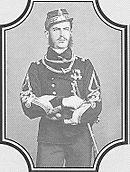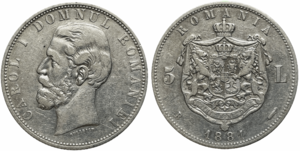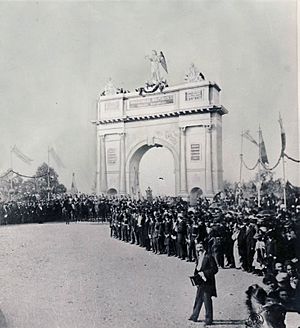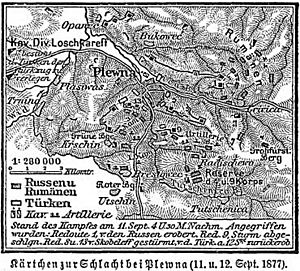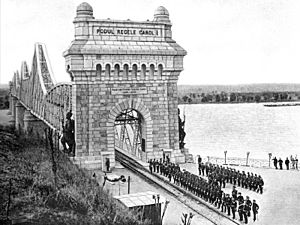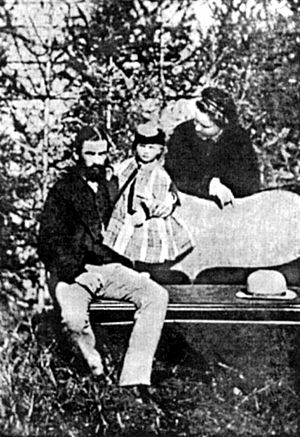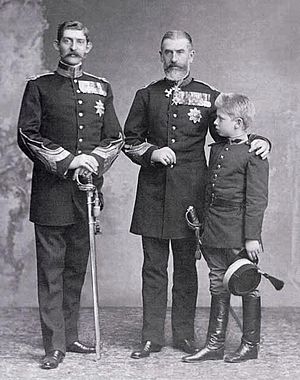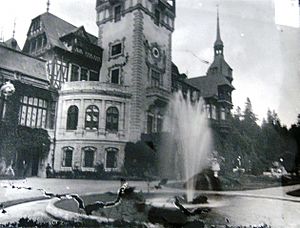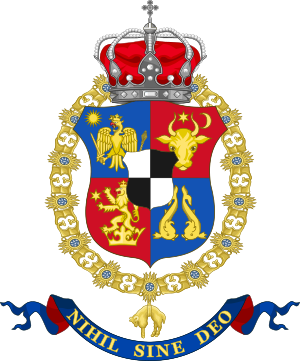Carol I of Romania facts for kids
Quick facts for kids Carol I |
|||||
|---|---|---|---|---|---|
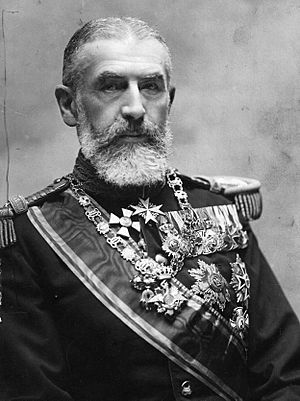
Carol I, c. 1905-14
|
|||||
| King of Romania | |||||
| Reign | 15 March 1881 – 10 October 1914 | ||||
| Coronation | 10 May 1881 | ||||
| Successor | Ferdinand I | ||||
| Domnitor of Romania | |||||
| Reign | 20 April 1866 – 14 March 1881 | ||||
| Predecessor | Alexandru Ioan Cuza | ||||
| Successor | Himself as King of Romania | ||||
| Born | 20 April 1839 Sigmaringen Castle, Sigmaringen, Hohenzollern-Sigmaringen, German Confederation |
||||
| Died | 10 October 1914 (aged 75) Peleș Castle, Sinaia, Kingdom of Romania |
||||
| Burial | Curtea de Argeș, Romania | ||||
| Spouse |
Elisabeth of Wied
(m. 1869) |
||||
| Issue | Princess Maria | ||||
|
|||||
| House | Hohenzollern-Sigmaringen | ||||
| Father | Karl Anton, Prince of Hohenzollern | ||||
| Mother | Princess Josephine of Baden | ||||
| Religion | Roman Catholicism | ||||
| Signature |  |
||||
Carol I (born Prince Karl of Hohenzollern-Sigmaringen) was a very important ruler of Romania. He was born on April 20, 1839, and passed away on October 10, 1914. He ruled Romania for a long time, from 1866 until his death in 1914.
He started as a Prince (called Domnitor) in 1866. Then, in 1881, he became the first King of Romania. He was chosen as Prince on April 20, 1866, after the previous ruler, Alexandru Ioan Cuza, was removed. Under Carol I, Romania became a truly independent country in 1877. This independence was officially recognized after the Russo-Turkish War in 1878.
Carol I was the first ruler from the Hohenzollern-Sigmaringen family. This family ruled Romania until 1947. During his time as ruler, Carol I helped Romania grow a lot. He improved its industries and roads. He also led Romanian troops in the Russo-Turkish War, which was a big moment for the country.
He married Princess Elisabeth of Wied in 1869. They had one daughter, Maria, but she sadly died when she was only three years old. Because Carol I had no sons, his nephew, Ferdinand, later became the next king.
Contents
Growing Up: Prince Karl's Early Life
Prince Karl Eitel Friedrich Zephyrinus Ludwig of Hohenzollern-Sigmaringen was born on April 20, 1839. His family was Catholic and lived in Sigmaringen. He was the second son of Prince Karl Anton and Princess Josephine of Baden.
Karl went to military schools, first in Münster and then in Berlin. He was a Prussian officer until 1866, when he accepted the crown of Romania. He even fought in the Second Schleswig War, which gave him useful military experience.
Even though he wasn't very tall or strong, Prince Karl was known as a perfect soldier. He was disciplined and healthy. He was also a good politician with modern ideas and could speak several European languages. His family was connected to the famous Bonaparte family in France, which helped him have good relationships with leaders like Napoleon III of France.
Becoming Prince of Romania
The previous ruler of Romania, Alexandru Ioan Cuza, had been removed from power. This left Romania in a difficult situation. The country was at risk of falling apart because European powers had only agreed to Romania's unification as long as Cuza was in charge.
Romanian politicians needed a new leader. Their first choice was Philip of Flanders, the brother of the King of Belgium. They hoped he would help Romania become like Belgium, a strong and modern country. But Philip refused the offer.
Then, Napoleon III of France suggested Karl. Napoleon's advice was important because Romania was very influenced by French culture. Napoleon also wanted Romania to be independent to increase French influence in the area. Karl's family connection to the Prussian royal family was another good point. A Romanian politician named Ion Brătianu went to talk to Karl and his family about him becoming the ruler of Romania.
Because of political tensions between Prussia and the Austrian Empire, Karl had to travel secretly. He used a Swiss passport under a different name, Karl Hettingen. He traveled by train and then by boat to Turnu Severin in Romania. There, Brătianu met him. Karl was formally elected as Prince on April 20, 1866.
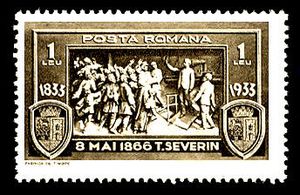
On May 10, 1866, Karl arrived in Bucharest, the capital city. Many people came out to welcome him. It had been a long time without rain, but it rained on the day he arrived. People saw this as a good sign. When he was crowned, Karl promised to protect Romania's laws, its people's rights, and its land. He said this in French because he didn't speak Romanian yet. It's even said he had never heard of Romania before being chosen! But he quickly learned Romanian and changed his name to the Romanian spelling, Carol.
First Years as Ruler
Romania's New Rules
Two months after Carol arrived, on June 29, 1866, the Romanian parliament created a new constitution. It was one of the most modern constitutions of its time. Carol signed it into law two days later.
This constitution was based on Belgium's constitution. It protected private property, freedom of speech, and freedom of the press. It also got rid of the death penalty during peacetime and separated the government's powers. However, it did not allow non-Christians to become citizens, which affected the Jewish population in the country.
This new constitution helped Romania grow and become more modern. It also bravely ignored the Ottoman Empire's power over Romania, which helped Romania become truly independent later on.
The constitution stated that the throne would be passed down through Carol's male family members. It also said that future rulers must be raised in the Eastern Orthodox Christian religion. Carol had executive power, but his actions needed to be approved by a minister. Still, he was a strong symbol of the nation and its unity.
Challenges and Changes
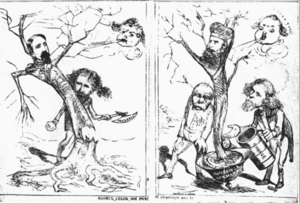
Even though Romania didn't fight in the Franco-Prussian War (1870–1871), this war still affected Carol's early rule. Carol was a German prince ruling a country that liked France. Because of this, some people didn't trust him. There were several attempts to make him give up his throne, usually led by politicians who wanted a republic.
One famous event happened on August 8, 1870, in the city of Ploiești. Some radical politicians tried to start a revolt and take over the city. They even declared the "Republic of Ploiești." But the revolt lasted less than 24 hours, and many of the leaders were arrested. After this, attempts to create a republic became rare, especially after Ion C. Brătianu, a Liberal leader, became prime minister and supported King Carol.
Fighting for Freedom: The War of Independence (1877–1878)
Why the War Started
Between 1875 and 1877, there were revolts against the Ottoman Empire in several Balkan countries, including Bulgaria. The Ottoman Empire's harsh response caused international anger, especially from Russia. Russia saw itself as a protector of Orthodox Christians.
After diplomatic efforts failed, Russia declared war on the Ottoman Empire on April 24, 1877. This started the Russo-Turkish War, which Romanians call the War of Independence.
Carol decided to let Russian troops pass through Romania to get to Bulgaria. This made the Ottoman Empire angry, and they bombed Romanian towns along the Danube River. At this time, Romania was already mostly independent, only paying a small tribute to the Ottomans.
Romania Joins the Fight
On May 10, 1877, Romania officially declared its independence. This ended the formal control the Ottoman Empire had over Romania since 1861. The Romanian Parliament voted for this declaration, and Prince Carol approved it.
Russia didn't want Romania to join the war actively. They thought it would give Romania too much say in the peace talks later. However, when the Russian army got stuck outside the Bulgarian town of Pleven, they urgently asked for Romania's help. Carol took command of the combined Russian and Romanian forces. After heavy fighting and a long siege, the Ottoman commander surrendered Pleven on November 28, 1877. This victory made Carol a national hero in Romania.
The Romanian army continued to fight in battles like Smârdan and Vidin. By early 1878, the Ottomans were losing. On March 3, they signed the Treaty of San Stefano, which recognized the independence of Romania, Serbia, and Montenegro.
After the War: A New Kingdom
After the war, the Treaty of Berlin officially recognized Romania as an independent country on July 13, 1878. Romania also gained a very valuable territory called Northern Dobruja. This gave Romania control of the mouth of the Danube River and access to the Black Sea. From 1878, Carol was called "Royal Highness."
On March 15, 1881, the constitution was changed to declare Romania a kingdom. Carol became the first King of Romania. On May 10, he was crowned king. The same 1866 Constitution was kept, but the word "prince" was changed to "king."
The Steel Crown used for Carol's coronation was made from an Ottoman cannon captured by the Romanian Army at Pleven. Since 2016, this crown is shown on the Romanian coat of arms.
King of Romania: Building a Nation
King Carol was a serious and focused leader. He always thought about the reputation of his royal family. His wife, Queen Elizabeth, even said he "wore the crown in his sleep." He was very organized and expected others to be the same. Even though he worked hard for Romania, he never forgot his German background.
In his 48 years of rule, the longest in Romanian history, he helped Romania become independent, improved its standing in the world, boosted its economy, and started a royal family line. In the Carpathian mountains, he built Peleș Castle in a German style. It's considered one of Europe's most beautiful castles and is still a popular place to visit in Romania.
After the Russo-Turkish War, Romania gained Northern Dobruja. To connect this new land to the rest of the country, Carol ordered a famous Romanian engineer, Anghel Saligny, to build the first modern permanent bridge over the Danube River. This bridge was the longest in Europe at the time and is still standing today.
The King had a lot of power in military and foreign policy decisions. In 1883, he secretly made an important alliance with the Central Powers. He did this without telling Parliament or many other people. Even when it was renewed in 1892, only a few top officials knew about it. The public didn't find out until World War I began.
On June 22, 1884, Parliament voted to give Carol and future kings a large royal estate, making him the biggest landowner in the country.
His reign brought constitutional monarchy and the early stages of democracy to Romania. Even though the constitution aimed to give most power to Parliament, the King had a lot of influence over elections. He would often switch power between the two main political parties. When he felt a ruling party had been in power long enough, he would bring in the opposition. The new government would then organize elections, which they would almost always win. This meant Parliament often reflected the government's wishes, not always the people's.
Between 1886 and 1887, there was a new idea to make Carol I the ruler of Bulgaria too. This would have created a personal union between Bulgaria and Romania. Carol was interested, but he had to say no because of pressure from Russia.
Last Years and World War I
In 1913, Romania got involved in the Second Balkan War and invaded Bulgaria. This led to the Treaty of Bucharest, which gave Romania more land, Southern Dobruja. This showed Romania's growing power in the region.
Carol's long rule helped Romania develop quickly. Towards the end of his life, as World War I was about to start, Carol wanted Romania to join the war on the side of the Central Powers. However, most Romanians liked France and wanted to support the Triple Entente (France, Britain, and Russia). Carol had signed a secret treaty in 1883 that linked Romania with the Triple Alliance (Germany, Austria-Hungary, and Italy). Even though the treaty was only meant to be used if Russia attacked one of the allies, Carol felt it was honorable to support Germany and his cousin, Emperor William II.
On August 3, 1914, an important meeting was held with the Crown Council. Carol told them about the secret treaty and his wish to join the war. But most of the council members strongly disagreed. They wanted Romania to stay neutral. Prime Minister Brătianu was especially strong in his desire for peace.
King Carol died on October 10, 1914. The new king, Ferdinand (influenced by his wife, Marie of Edinburgh, a British princess), listened more to what the public wanted. He eventually brought Romania into the war on the side of the Allies in 1916.
Life and Family
When Carol was chosen as Prince of Romania, he was not married. In 1869, he traveled around Europe, especially Germany, to find a wife. He met and married Princess Elizabeth of Wied on November 15, 1869.
Their marriage was a bit unusual. Carol was a serious and practical man, while Elizabeth was a dreamer who wrote books under the name Carmen Sylva. They had one child, a daughter named Maria, born in 1870. Sadly, she died on April 9, 1874, when she was only three years old. Because the constitution said only male descendants could inherit the throne, Maria could not have become queen anyway. Losing their only child made the royal couple grow apart for a while. Elizabeth never fully recovered from the sadness.
After Romania became a Kingdom in 1881, the question of who would rule next was very important. Carol's older brother, Leopold, and Leopold's oldest son, William, both gave up their rights to the throne. So, Leopold's second son, Ferdinand, was named Prince of Romania and the next in line to the throne in 1886.
Towards the end of Carol's life, he and Elizabeth found a way to understand each other better and became good friends. Carol died on October 10, 1914, at the age of 75.
Legacy: Carol I's Place in History
Today, Carol I is seen as a very important figure in Romanian history. He is often shown in history books as a great leader, like Decebalus, Stephen the Great, Michael the Brave, or Alexandru Ioan Cuza.
During the Communist era in Romania, Carol and other monarchs were criticized by historians. He was sometimes described as a foreign prince who only cared about money and was controlled by other powerful countries. He was also sometimes blamed for the 1907 Peasant Revolt. However, starting in the 1970s, some historians began to see his rule as a time of national progress and recognized his role in keeping Romania united.
After the fall of Communism in 1989, the monarchy was seen in a much more positive light. Carol is now considered a symbol of national unity and the founder of the modern Romanian state. In 2006, during a TV show called "100 Greatest Romanians," Carol I was voted the second greatest Romanian ever, after only Stephen the Great.
Several important places are named in his honor, including the Carol I National Defence University and the Central University Library in Bucharest, and the Carol I National College in Craiova.
The Order of Carol I was created in 1906. It was the highest honor given by the Romanian Kingdom until 1947. In 2005, the Romanian royal family brought it back as a special family award.
Honours
| Styles of King Carol I of Romania |
|
|---|---|
| Reference style | His Majesty |
| Spoken style | Your Majesty |
Carol I received many awards and honors from Romania and other countries throughout his life.
- National awards
 Romania:
Romania:
- Founder of the Order of the Crown of Romania, 1881
- Founder of the Order of Carol I, 1906
- Foreign awards
 Austrian Empire: Knight of the Golden Fleece, 1884
Austrian Empire: Knight of the Golden Fleece, 1884 France: Grand Cross of the Legion of Honour
France: Grand Cross of the Legion of Honour Prussia: Pour le Mérite (military), 1877
Prussia: Pour le Mérite (military), 1877 Russia: Knight of St. George, 3rd Class, 1877
Russia: Knight of St. George, 3rd Class, 1877 United Kingdom: Stranger Knight of the Garter, 1892
United Kingdom: Stranger Knight of the Garter, 1892
Images for kids
See also
 In Spanish: Carlos I de Rumania para niños
In Spanish: Carlos I de Rumania para niños



